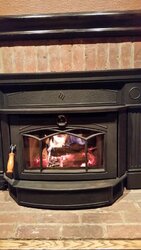Hello all, I am currently installing a Hampton HI300 in existing masonry fireplace. Specs: flu is 30' tall interior chimney. I've already installed the stainless smoothwall 6" liner. The liner is wrapped with 1/4" insulation for the first 8' down from the top. I couldn't get any further down because it was getting ripped to shreds on its way down beyond that. From the top I jammed in about 2' - 3' of roxul between the clay flu and the liner so it is sealed pretty tight up at the top.
I have read the 2 schools of thought on this terrific forum about whether or not to install blocking plates and would like to know what the consensus opinion is on my specific application for whether or not I should use a blocking plate for my install. FYI, I plan to make a good seal around the inserts façade so not too much air can slip by that way.
I have read the 2 schools of thought on this terrific forum about whether or not to install blocking plates and would like to know what the consensus opinion is on my specific application for whether or not I should use a blocking plate for my install. FYI, I plan to make a good seal around the inserts façade so not too much air can slip by that way.



